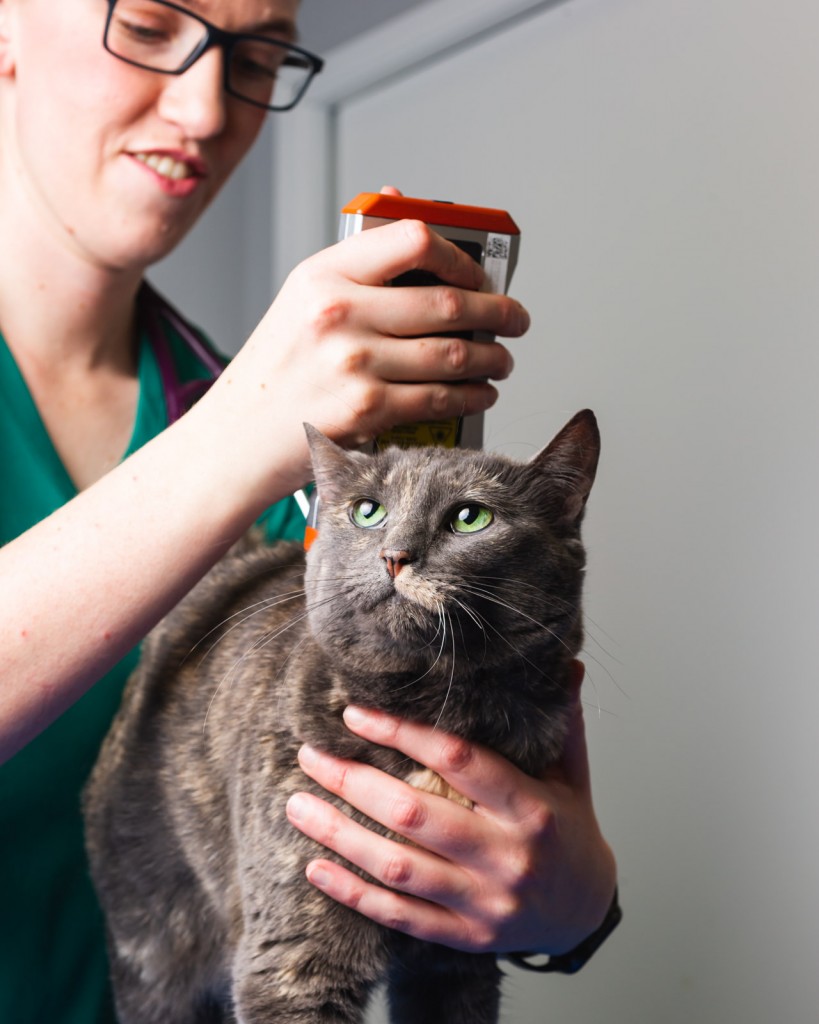Laser Therapy
April 27th 2020
What is laser therapy?
Laser therapy stimulates tissue and cells in the body to undergo repair, reduce inflammation, and reduce pain, in a process known as photobiomodulation.
How does laser therapy work?
Lasers produce a single wavelength of unicolored light. The light is then collimated (focused), allowing it to pass under the skin and penetrate underlying tissues. The longer the wavelength used, the more profound the penetration of the targeted tissue. Once within the tissue, the photons (particles of light) react with specific receptors within cells known as chromophores which stimulate the cells and the affected tissues to undergo a variety of different biological reactions: energy production, increased cell replication, beta-endorphin release and a decrease in inflammatory markers. Overall, these process help produce analgesic (pain relief), and anti-inflammatory effects at the targeted tissue.
What is laser therapy used for?
In Veterinary medicine, laser therapy is used for a wide variety of different treatments. This can include but is not limited to accelerated healing of surgical incisions, wound care, rehabilitation and pain management. Laser therapy can be implemented in multimodal treatment programs to assist with reducing pain/inflammation, increasing circulation and promote peripheral nerve recovery. Research is still in the process of uncovering potential benefits of this new modality and how it exactly works.
Are there any safety concerns with laser therapy?
Both patient and operator should wear protective eyewear as the most effective therapeutic lasers fall under “classes 3 or 4.” The classification of lasers are based on their ability to damage the eye with class 4 being the most potent -- hence the need for protection. (Photo for illustration purposes only, laser was not on.)
Are there any side effects?
There are no reported side-effects of using laser.
References
1.Milis D and Levine D. Canine Rehabilitation and Physical Therapy. 2nd edn. Elsevier, China, 2014.
2.Gross DM. Introduction to Therapeutic Lasers in Rehabilitation Setting. Topics in Companion Animal Medicine 2014;29:49-53.
3.Moore KC, Naru H, Broome IJ. The effects of infra-red diode laser irradation on the duration and severity of postoperative pain: double blind trial. Laser Therapy 1993;4:145-149.
Laser therapy stimulates tissue and cells in the body to undergo repair, reduce inflammation, and reduce pain, in a process known as photobiomodulation.
How does laser therapy work?
Lasers produce a single wavelength of unicolored light. The light is then collimated (focused), allowing it to pass under the skin and penetrate underlying tissues. The longer the wavelength used, the more profound the penetration of the targeted tissue. Once within the tissue, the photons (particles of light) react with specific receptors within cells known as chromophores which stimulate the cells and the affected tissues to undergo a variety of different biological reactions: energy production, increased cell replication, beta-endorphin release and a decrease in inflammatory markers. Overall, these process help produce analgesic (pain relief), and anti-inflammatory effects at the targeted tissue.
What is laser therapy used for?
In Veterinary medicine, laser therapy is used for a wide variety of different treatments. This can include but is not limited to accelerated healing of surgical incisions, wound care, rehabilitation and pain management. Laser therapy can be implemented in multimodal treatment programs to assist with reducing pain/inflammation, increasing circulation and promote peripheral nerve recovery. Research is still in the process of uncovering potential benefits of this new modality and how it exactly works.
Are there any safety concerns with laser therapy?
Both patient and operator should wear protective eyewear as the most effective therapeutic lasers fall under “classes 3 or 4.” The classification of lasers are based on their ability to damage the eye with class 4 being the most potent -- hence the need for protection. (Photo for illustration purposes only, laser was not on.)
Are there any side effects?
There are no reported side-effects of using laser.
References
1.Milis D and Levine D. Canine Rehabilitation and Physical Therapy. 2nd edn. Elsevier, China, 2014.
2.Gross DM. Introduction to Therapeutic Lasers in Rehabilitation Setting. Topics in Companion Animal Medicine 2014;29:49-53.
3.Moore KC, Naru H, Broome IJ. The effects of infra-red diode laser irradation on the duration and severity of postoperative pain: double blind trial. Laser Therapy 1993;4:145-149.

Click to close
